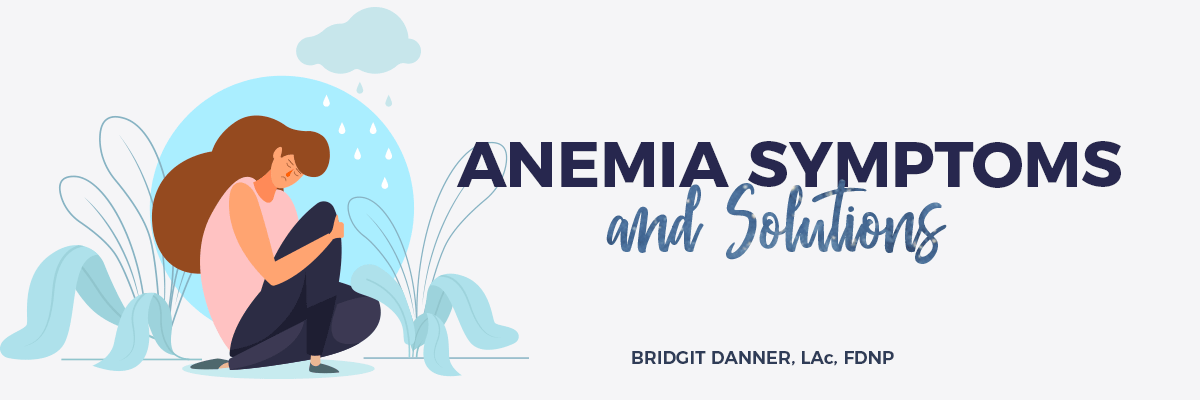Anemia Symptoms and Solutions
Anemia Could Explain All Your Symptoms, But No One Is Checking for It
The National Health and Nutrition Examination Surveys (NHANES) found that between 2003 and 2012, more than 6% of the American population exhibited anemic symptoms. (1) This is over 15 million people with anemia!
So with that many people affected by the disease, why don’t we hear more about it? Learn more below!
Anemia Symptoms
This common problem is often involved in chronic health issues, but is not always discovered quickly, as doctors often overlook anemia for more complex diagnosis.
The following are common anemia symptoms: (2)
Fatigue/loss of energy
Rapid heartbeat
Shortness of breath
Headache
Insomnia
Pale skin
Muscle cramps
Difficulty concentrating
Additional symptoms can appear, based on the specific type of anemia that you are dealing with (see below in this article to learn more about each type). For example:
Symptoms of iron-deficiency anemia: pica, koilonychia, and soreness and cracking around the mouth. (4, 8) Pica is the urge to want to eat non-food items like paper or dirt. Koilonychias results when iron levels fall below normal ranges and cause your nails to change shape. They will often curve inward and have a spoon-like appearance.
Symptoms of vitamin B deficiency anemia: tingling in the hands and feet, wobbly gait, and even memory loss. (2, 5, 6, 7) Pernicious anemia or megaloblastic anemia both involve a lack of vitamin B12 and/or B9. These are heavily involved with neuron maintenance, so a deficiency will affect both your red blood cells and your pain signaling, muscle control, and brain.
Below you’ll learn what anemia actually is, how to identify the different forms of anemia, and ways you can address the problem.
What Is Anemia?
Anemia is a condition where there is either a lack of red blood cells (RBCs) or not enough hemoglobin present (or both). Hemoglobin is found inside RBCs and is the primary vehicle that carries oxygen to tissues throughout your entire body. (1, 2)
Without enough RBCs or hemoglobin, your muscles and other tissues will become starved for oxygen and will begin malfunctioning.
Your genetics, diet, and even medications you take can contribute to the development of anemia. (1, 2)
Why Is Anemia Overlooked?
Just by looking at the list of symptoms associated with anemia, it is easy to understand why this diagnosis is often overlooked. Every symptom is vague and could describe another disease. For example, headache, insomnia, muscle cramps, fatigue, and rapid heartbeat could all be explained by dehydration or electrolyte imbalance.
Anemia may simply be overlooked because it doesn’t pose as immediate of a risk compared to something like an infection or cancer. Doctors are trained to tackle high-risk diagnoses and work their way back. Not surprisingly then, nurses are often the ones to recognize anemia in hospitalized patients before physicians. (8, 9) Regardless of why it is overlooked, blood tests are the best way to diagnose anemia.
Types of Anemia
The people most likely to develop anemia are women, children, and those with other chronic diseases. This makes sense when you consider some of the things that cause the condition. Most people are familiar with anemia, but few know much about the disease. In fact, there are over 400 types of anemia, but only a handful of them are common. Some of the basic types of anemia include:
Hemolytic anemia
Microcytic anemia
Pernicious anemia
Megaloblastic anemia
Hemolytic Anemia
Hemolytic anemia is defined by the destruction of RBCs. The average life of an RBC is 120 days, however, people with hemolytic anemia have their RBCs broken down much sooner than that. Hemolytic anemia can be inherited or acquired. Inherited means the disease was passed down to you from one or both of your parents whereas acquired means the disease developed over time as a result of environment, medication, or dietary factors. (2)
Microcytic Anemia
When iron deficiency occurs anemia is likely. Microcytic anemia is a specific type of iron-deficiency anemia that produces smaller than normal RBCs. This is because iron is important for hemoglobin production in the RBCs. (3, 4) Iron-deficiency anemia symptoms often arise in women following menstruation. This is because the rapid blood loss also results in a significant drop in iron.
Pernicious Anemia
Pernicious anemia occurs when the intestines are unable to properly absorb vitamin B12. For vitamin B12 to be absorbed in the gut, a unique protein called intrinsic factor (IF) must be present. Low levels of IF may be the result of an autoimmune condition or thyroid dysfunction. (5, 6) Things like “leaky gut” or gut inflammation can also impact vitamin B12 absorption. You can learn more about leaky gut in my blog post here. Pernicious anemia is most often diagnosed in people 30 and older. (2)
Megaloblastic Anemia
Folate is part of the vitamin B family, vitamin B9. Like vitamin B12, it is involved in RBC production. While its absorption isn’t tied to IF, there are many reasons that people may become folate deficiency. Regardless, folate deficiency or vitamin B12 deficiency can result in RBCs that are big, like “mega” big. This is why it is often called megaloblastic anemia. Things like poor diet and alcohol can contribute to folate-deficiency. (7)
Sources of Iron
Iron found in food will fall into one of two different categories; heme- or non-heme iron. Heme iron is going to be found in a state that is much more similar to the iron found floating in your blood right now. An easy way to distinguish between heme- and non-heme iron rich foods is animal vs plant. Great sources of heme- iron rich foods include: (10)
Chicken liver
Oysters
Clams beef liver
Beef
Turkey
Tuna
Eggs
Shrimp
Lamb
Organ meats (here is my favorite high-quality organ complex)
Non-heme sources of iron include: (10)
Beans
Enriched Raisin Bran
Tofu
Lentils
Spinach
Peanut Butter
Brown Rice
Since heme-iron is already very similar to the iron found in your blood, it is absorbed much more efficiently than non-heme iron. If you are looking for the best possible food sources of iron, you should stick to those that contain heme-iron. In addition to these iron rich foods, you may want to consider supplementing.
Why Is My Iron Low?
The type of iron you’re consuming from food plays a large role in how well it will be absorbed.
Gut inflammation can also reduce your ability to absorb iron. (3) Other things that will decrease iron absorption include medications commonly taken for heartburn/acid reflux. This includes antacids, PPIs, and calcium supplements. (11)
If you’re trying to improve your iron status, it will be important to check your ferritin level. Ferritin is responsible for storing iron when times are good and releasing iron when times are bad in order to maintain blood iron levels.
Normal ferritin levels in the blood should fall within these ranges:
Women 18-39 years old 10-120ng/ml
Women 40+ years old 12-263ng/ml
Men 18+ years old 20-250ng/ml
Children 6mos – 15 years old 7-140ng/ml
When ferritin levels fall too low it is a sign of poor iron status. That alone is not enough to diagnose anemia, but it does help paint a full picture. (12)
Sources of B Vitamins
Animal products tend to be the richest sources of vitamin B12. Folate, on the other hand, is found in fruits and vegetables at high levels.
Vitamin B12 (13)
Tuna
Trout
Clams
Beef
Beef Liver
Salmon
Folate (14)
Spinach
Broccoli
Beans
Peas
Lentils
Lemons
Bananas
Melons
Why Are My B Vitamins Low?
Folate- and B12-deficiencies can arise for a variety of reasons. Absorption of both B12 and folate are often blocked by common medications. Just like heartburn medication can block iron absorption, it can also prevent vitamin B absorption. Another common medication the depletes B12 and folate is metformin. Not to mention, we lose the ability to absorb B vitamins as we age. This is all part of the reason anemia is more prevalent than people realize.
How to Address Your Anemia
1. Get Tested!
The best way to assess whether or not you have anemia is to run complete blood count (CBC), iron, ferritin, vitamin B12, IF antibody, and folate labs. You can find this and more here. A CBC will determine if you have below normal RBCs or hemoglobin levels as well as your mean corpuscular volume. When these are low, it suggests anemia.
Ferritin is the storage protein that your body uses to save iron for a rainy day. When ferritin levels get too low it will often mean that you are low on iron which can contribute to anemia.
Ferritin, hemoglobin and other red blood cells markers (indicating levels of B vitamins) are included in our Thyroid Plus Lab Testing package.
If you do find out you have anemia it is important to take the right steps to correct the issue. Get to the root cause!
2. Increase Levels Through Supplementation
For people that have iron-deficiency, vitamin B12-deficiency, or folate-deficiency associated anemia, you need to start getting your nutrient levels up.
A. Improve Your Iron Status with Ortho Iron
Ortho Iron™ is a complete formula that helps the body maintain healthy iron levels to promote healthy red blood cell formation. With a combination of high-quality ingredients, such as SunActive® iron, this supplement provides the necessary support for those who require more than what their diet alone provides in an easy-to-absorb formula. Most supplements on the market use iron salts (i.e. iron sulfate), but, unfortunately, these forms of iron are poorly absorbed, often irritate the gut, and may lead to constipation.
Ortho Iron is a registered form of iron: the iron protein succinylate (IPS). IPS enhances iron absorption in the gut and reduces irritation. The product also contains lactoferrin which can help increase iron absorption by nearly 6x. (15) Along with that, lactoferrin can help the immune system fight off a variety of infections.
B. Get All Your B Vitamins Daily with Hi-Potency Multivitamin
B vitamins are considered water-soluble vitamins. This means they are not stored in the body for later use.
Both vitamin B12 and folate are involved in hundreds of metabolic processes throughout the body every day. Your body will use up all of the B vitamins it needs to get the job done every day. Any excess of water soluble vitamins like B12 and folate are simply excreted in your sweat and urine. In order to maintain optimal levels, it is important to consume your B vitamins daily. Hi-Potency Multivitamin contains all the B vitamins you need to prevent deficiencies that lead to anemia.
C. Load Up on B12
I find that many women are low in B12, even when supplementing. Our sublingual B12 is an easy, affordable one-a-day to ensure you are getting your B12.
The big reason I started carrying this supplement is because it helped me so much with my own cellular fatigue as I dealt with toxic mold poisoning. Sublingual B12 is my little energy pill!
Get All My Favorite Anemia-Fighting Products!
Have you found through lab testing that you are low in B vitamins and iron? Do you have excessively heavy periods? Do you find yourself short of breath easily, or chronically fatigued?
You can find out more with us through testing, or simply grab our Ortho Iron, Vitamin B12 Lozenges, and Hi-Potency Multivitamin to boost your nutrient levels.
If you are still menstruating, try Ortho Iron, especially if you've been told you are low on iron. If you iron has been ok or your do not menstruate, start with just the Vitamin B12 Lozenges and Hi-Potency Multivitamin until you have further testing.
Do you struggle with anemia? What have you learned? Share with us in the comments below!
Bridgit Danner, LAc, FDNP, is trained in functional health coaching and has worked with thousands of women over her career since 2004. She is the founder of Women’s Wellness Collaborative llc and HormoneDetoxShop.com.
Check our her easy 5-Day DIY Detox Guide here!



![Hi-Potency-Update-New-Label__47808.1606156793[1].jpg](https://images.squarespace-cdn.com/content/v1/53b1df7ee4b0dc3e7be6bb86/1609406308137-SZ39XYVDMACFHVWN247Q/Hi-Potency-Update-New-Label__47808.1606156793%5B1%5D.jpg)


